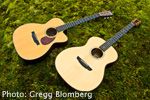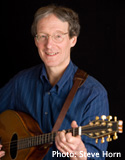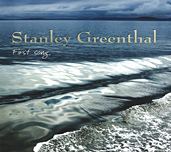Gallery of Strings & Drums
Introduction
This page w/1st 20 images » w/next 20 images »
 Besides the human voice, the guitar was the first instrument whose sound immediately attracted me. Shortly after I turned 14, the summer my father died, I rented a guitar for a dollar a week, and became immersed in learning to play basic guitar chords. Although the instrument was difficult to play because of its almost impossibly high string action, it was the sound of those first imperfectly made chords that became the entry point for my playing music. That chordal sound joined with the sound of the human voice, singing together.
Besides the human voice, the guitar was the first instrument whose sound immediately attracted me. Shortly after I turned 14, the summer my father died, I rented a guitar for a dollar a week, and became immersed in learning to play basic guitar chords. Although the instrument was difficult to play because of its almost impossibly high string action, it was the sound of those first imperfectly made chords that became the entry point for my playing music. That chordal sound joined with the sound of the human voice, singing together.
The guitar is still the primary instrument that inspires my songwriting. When I recorded my first album of original songs and instrumentals, Songs for the Journey (1986), I was playing the guitar in standard tuning and also in DADGAD. After some years of tuning the guitar up and down, alternating between the two tunings, I eventually decided to stay with DADGAD for all the music I compose and arrange for guitar. I even relearned pieces I had written in standard tuning to play them in my new “standard” tuning, DADGAD. With many choices for drone notes and open, complex sounding chords to accompany an array of beautiful Irish, Scottish and Breton melodies, I was hooked for all time.
I presently tune my Goodall Grand Concert and my Collings OM2 in DADGAD, and continue to discover many musical riches within this versatile tuning, so well suited for all kinds of music.
With my interest in a variety of Celtic music, and after a brief period of playing Irish tunes on the mandolin, I then became fascinated with the sound of the Irish bouzouki (or octave mandolin, cittern), first introduced into Irish music in the late 1960’s. My long time favorite instrument of this kind is an arch-top mandocello built by John Stump of Portland, Oregon, which I have played since 1983. John calls it a mandocello, as it is based upon the Gibson mandocello body design and scale length. He further refined the instrument to produce expansive overtones, and giving it a punchy, resonant projection. It has eight strings arranged in four pairs, originally tuned in unison, GG DD aa dd. I eventually replaced the two lower unison pairs with higher octave strings, and I play it in this tuning today (gG Dd aa dd).
In 2008 I acquired a wonderful new flat-top bouzouki with a guitar-style pin bridge, made by Herb Taylor of Golden, Colorado. The contrast in sound between the mandocello and Herb’s model #86 bouzouki perfectly compliment one another. I tune the bouzouki in unison pairs, (GG DD aa dd). The unison tuning enhances the thicker, darker guitar-like voice of the bouzouki.
At some point, I discovered the sparkling sound of the four-string tenor guitar. I use it mainly in conjunction with the guitar, mandocello and bouzouki, to obtain a high shimmering string voice above those instruments. The 1960’s Martin O-18T tenor guitar is tuned CGdg, a fourth higher than the mandocello and bouzouki, while the Gibson arch-top tenor is tuned like the mandocello and bouzouki, GDad.
During the 1970’s and 80’s, my early interest in Balkan and Greek music grew out of hearing the Irish group Planxty, with Andy Irvine’s influence in their ground breaking arrangements for mandolin, bouzouki and guitar. That led me to explore the sources of those musical traditions. The first traditional instrument I acquired was a Bulgarian tambura, made in Bulgaria by Stefan Stefanov. The tambura has four pairs of strings, usually tuned like the top four strings of a guitar, (DD gg bb ee). However, I tune it gg DD aa dd, to suit my own style of playing.
It wasn’t until 2004, however, that I was introduced to the mysterious sound of the lavta— a small Turkish lute. It was originally used in classical Ottoman music up until the end of the 20th century when it almost died out. Rediscovered 25 years or so ago by traditional musicians from Greece and Turkey, it is now played in contemporary Greek, Cretan and Turkish folk music as well as in its classical Ottoman music context. I first heard a lavta played live by my friend Paddy League, who had brought his lavta back to the U.S. from Greece. It was built in Athens by Dimitris Rapakousios, a craftsman and instrument maker of the highest caliber, who builds many kinds of traditional string instruments found in contemporary Greek, Cretan and Turkish music. Not long after hearing Paddy’s lavta , I contacted Dimitris, who then made one for me. The lavta’s nylon strings produce the dark, vibrant sound of wood, similar to the oud but a bit more percussive in its affect. It is tuned D AA DD aa, and has seven strings, three unison pairs with a single low D string.
The lavta drew me to hearing and learning to play other string instruments from Greece. Dimitris next built for me his design of the Cretan laouto, the lute-like instrument used in Crete to accompany the lyra, and also as a solo instrument. I finally had the pleasure of meeting Dimitris in 2006, when I traveled to Athens and then on to Crete to participate in the Labyrinth Musical Workshop, founded and directed by Ross Daly, renowned composer/instrumentalist in modal music traditions. During my time at Labyrinth, I fell for the sound of a Greek Mainland laouto on display in the Museum of Musical Instruments there in the village of Houdesti. When I told Dimitris of my interest in having him build me a Mainland laouto some day in the future, he surprised me by building me an instrument of unsurpassed beauty, completing it in time for me to bring it back with me when I returned to the U.S. In contrast to the lavta, both the Mainland laouto and Cretan laouto are strung with metal strings that create a percussive textured string sound for melody playing and providing rhythmic accompaniment. The Mainland laouto is traditionally tuned Cc Gg Dd aa, with octave strings on the three lower pairs. It has a re-entrant tuning, because (Gg) is tuned a fourth lower than (Cc). Unlike the traditional tuning, I tune the Mainland laouto Cc Gg Dd gg. The lower pitched Cretan laouto is traditionally tuned Gg Dd Aa ee. It also has a re-entrant tuning, as (Dd) is a fourth lower than (Gg). However, I tune my Cretan laouto Gg Dd Aa Dd, with octave pairs on all four courses.
The percussion instrument my wife Kip and I play is the frame drum, variously called bendir, tar, dayerah or daff, in different musical traditions. The two bendirs pictured in the gallery were made by Abdulhamid Alwan of Milwaukee, Wisconsin. These bendirs have goatskins, which subject them to pitch variation due to changes in temperature and humidity. In spite of their tempermental personalities, their sound is incomparably expressive. Alive and resonant, these drums are the heart beat of much of our music.
 I hope you enjoy exploring the images of all the instruments in their various settings in the gallery.
I hope you enjoy exploring the images of all the instruments in their various settings in the gallery.










































